|

|
 |
|
Last Updated: Feb 13, 2017 - 1:45:37 AM |
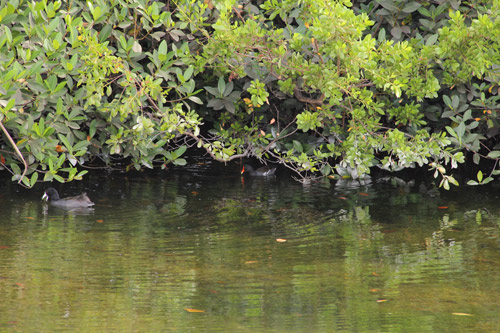
One of the many species of birds is pictured wading in the water at Big Pond Development Park. (BIS Photo/Letisha Henderson)
|
NASSAU, The Bahamas – Once filled with vast mounds of trash, the former Baillou Hill Road landfill is gradually being transformed into a picnic shelter, play area fitted with a basketball court, multi-use trails and a toilet block.
Big Pond Development Park is a “unique” feature located in the heart of the urban setting of Celery Drive and Tucker Road and according to Tanya Ferguson Environmental Specialist in the Ministry of Works and Urban Development, transformation of the park is improving an existing feature that was very much unknown.
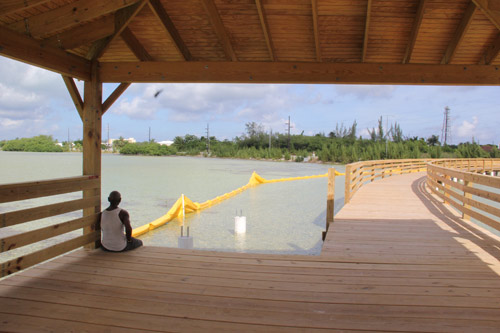
A gentleman relaxes on the boardwalk at Big Pond Development Park. (BIS Photo/Letisha Henderson)
|
The project is being conducted in conjunction with the New Providence Road Improvement Project and serves as a means of mitigating loss of the natural environment associated with the roads. “There were a lot of areas where we actually had to go through an eco-system in order to build the road. To mitigate for that, the Big Pond Park Project was chosen as a project that would offset the damages that would have occurred,” said Ferguson.
The park is being developed in five phases. Kurt Smith Resident Engineer at the Ministry of Works and Urban Development said the initial phase will create the hub for the park. The toilet block, the picnic shelter and the playground area are included in the first phase.
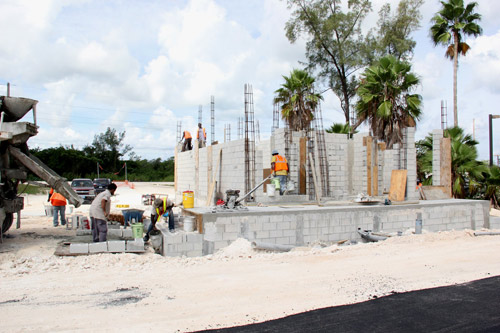
A toilet block is under construction at Big Pond Development Park. (BIS Photo/Letisha Henderson)
|
“The ideal project for the park is extensive trails that will run all around Big Pond itself and connect to the hub area, to the parking lot, to the sidewalks on Baillou Hill Road,” said Smith. “We have an extensive network of trails that run around the pond. Within this phase we have a limited amount of trails mainly focusing on connecting from the hub and connecting to the boardwalk area. It is still a significant amount of trails but once the overall phases are finished you will have trails connecting to the Sports Centre, to Corridor 8, which is to the north of Big Pond. We will have an extensive network of multi-use trails for walking, riding and more.”
In addition to relaxation and enjoyment, the Big Pond Park creates an educational opportunity.
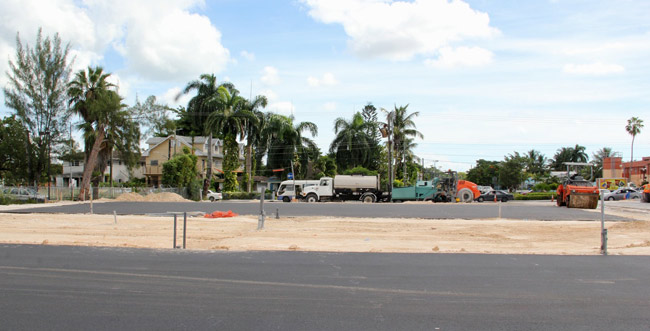
The photo shows the parking facilities at Big Pond Development Park. (BIS Photo/Letisha Henderson)
|
“It’s in an urban setting but it’s also very unique in that for The Bahamas we usually see red mangrove systems along the coast, so this is unique in having it in an in-land feature. We have red mangroves that are 25 feet, and its system supports a very healthy and vibrant bird population,” said Ferguson.
Surveys indicate that there are over 70 species of birds for which the pond provides a habitat. Among them are the White Cheeked Pintail, the Common Moorhen, which is the most popular bird of all that that visits the pond. Beyond Big Pond itself, and extending to the Sports Centre are pockets of coppice forest and canopy vegetation that support woodland species of birds. Here, there are endangered and threatened species of birds.
“The pond itself is thriving. With the introduction of the native landscaping there will be removal of invasive species, which will be replaced with native species that will attract more and more wildlife. Before we came in it was already a thriving system but of course the enhancements like native landscaping will definitely add to it,” Ferguson said.
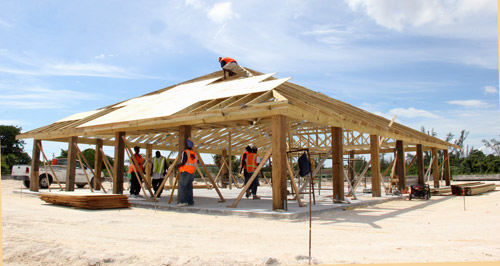
Workmen are shown putting on the roof of a picnic shelter at Big Pond Development Park. (BIS Photo/Letisha Henderson)
|
Also in the pond are species of fish including the Small Mosquito Fish and Tilapia, which is the most common and of a significant amount. “We were very surprised especially when we put up the environmental control to ensure that during construction, debris and turbidity were not extended outside of the work zone. So when we put those up we were very surprised to see a huge number of fish in the pond. We also just recently discovered that there are a few turtles in the pond but they are not native. We suspect that they were released from a household or wandered over. I’m sure it’s going to be a treat for the children to see the diversity of species that are supported here in the pond.”
With The College of The Bahamas (COB) not too far away, Ferguson described the Big Pond Development Park as a “living laboratory” for the institution. “We have plans to accommodate COB not only in terms of using the facilities for classroom purposes, but also for a monitoring programme that we want to implement. Having students of tertiary education be a part of that is also going to beneficial to the college experience and getting a first hand knowledge of these things,” said Ferguson.
A significant part of the developmental process for future phases of the Big Pond Park Project includes removal of invasive species to be replaced with native vegetation.
“Once we’re finished with the first phase we definitely have enough elements to be fully operational to be used by Bahamians and tourists. This is important in promoting eco-tourism. It is an addition to the national park system and this will offer a different element in terms of an in-land feature.
“Over the years we have made significant strides in terms of educating the public and getting the public to see these as alternatives for recreation. With this being in the backyard of the people it makes it an even better opportunity because you literally can take a stroll here, sit and enjoy the vista without getting in a car, ” added Ferguson.
During the extensive landscaping phase Casuarina trees, among the invasive species along the banks of the pond, will be removed and replaced with native species to beautify the park.
Smith said future plans are to construct a community centre which will house descriptive photos and examples of native species, flora and fauna to educate visitors who come to the community centre.
“The community center planned in the future will essentially be somewhat of a museum of the native flora and flauna in The Bahamas. Along the trails will be interpretive signs of the implemented native landscaping and will describe what type of plant it is, what type of tree it is etc. We will be able to also see different plants and flora and fauna in the community center. This is also a part of the eco-tourism.
Smith advised that signs will be posted to indicate what one can and cannot do. The pond itself should not be used for any type of activity like fishing, swimming or any type of water sports. “The overall site was a contaminated dumpsite. While we have done remediation to the soil itself, we have not done any remediation to the pond itself.”
Ferguson added, “There are plans to remediate the pond so that one day you can come out here, bring your kayak, meander through the mangroves, and enjoy the full experience of the pond and the terrestrial areas.”

© Copyright 2014 by thebahamasweekly.com
Top of Page
|
|
 |

|
